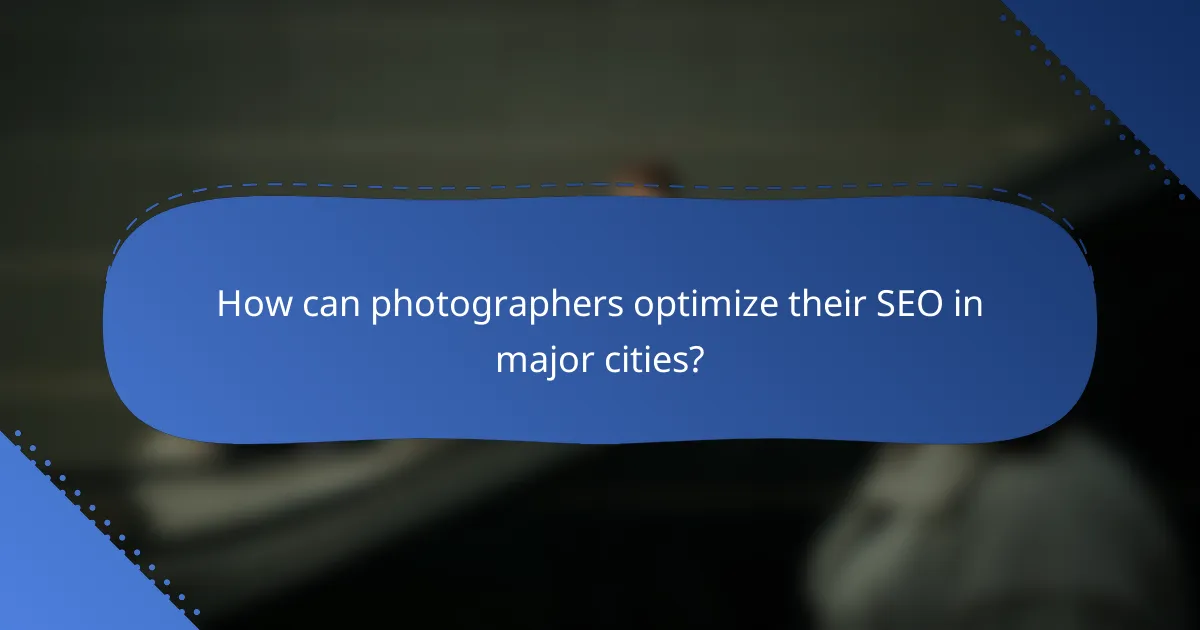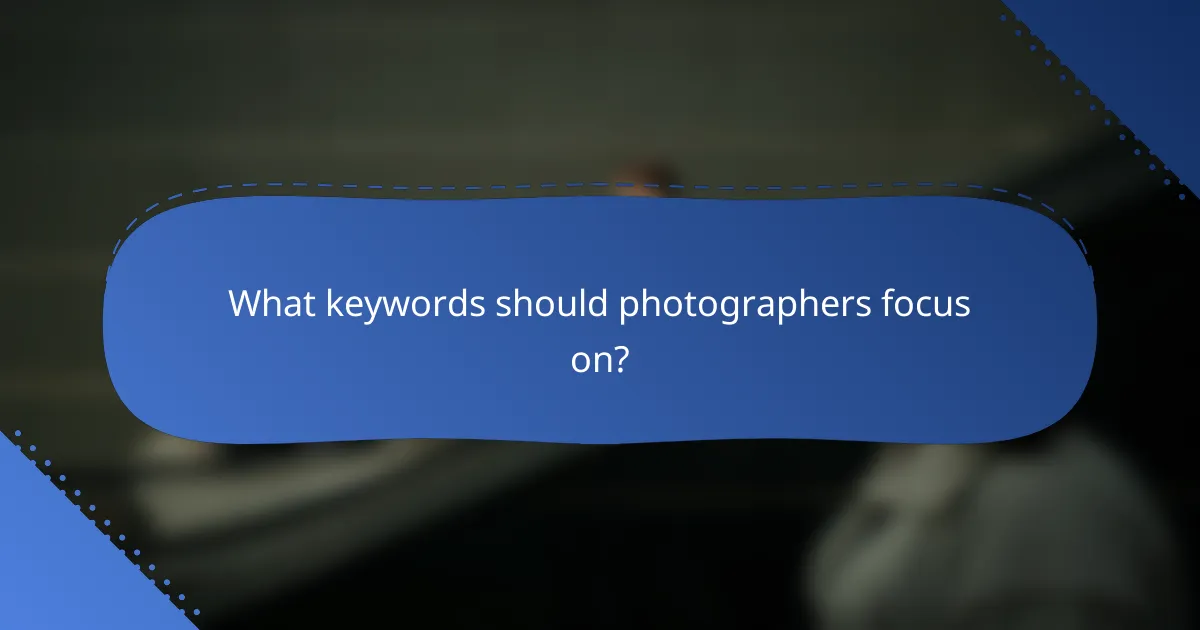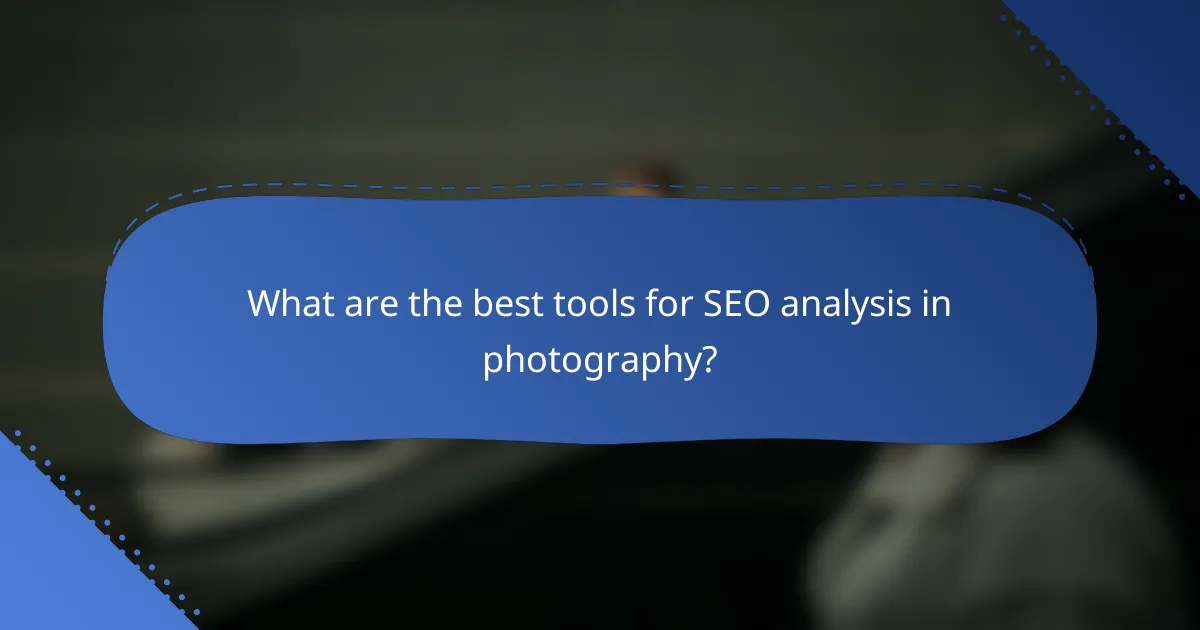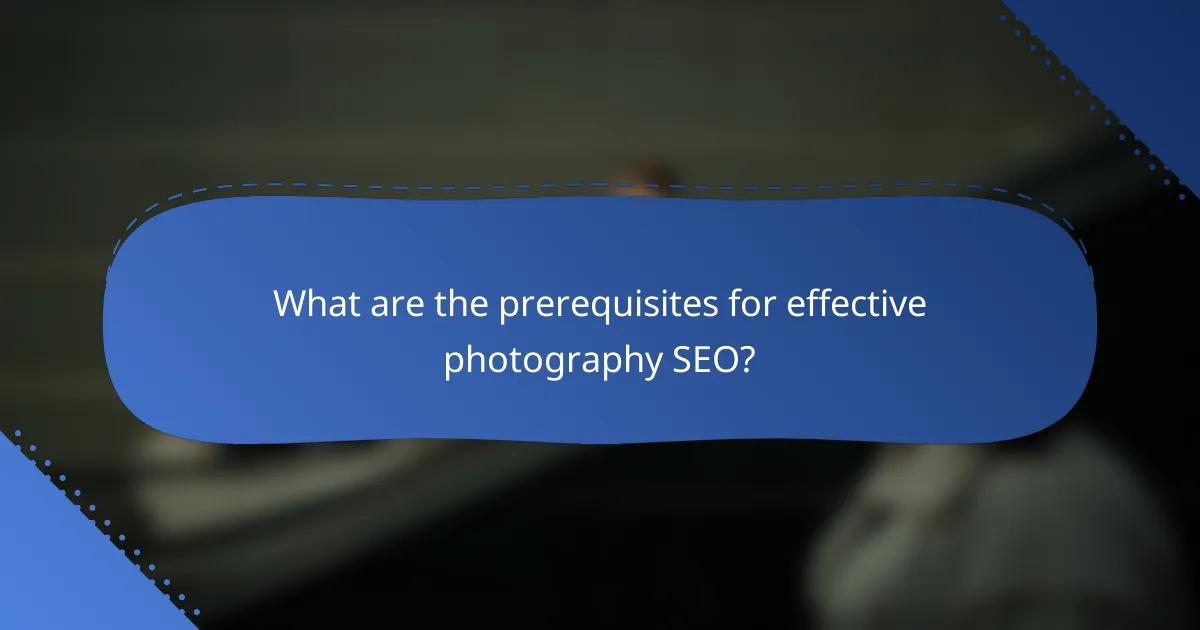Effective SEO strategies are essential for photographers looking to enhance their online visibility and attract potential clients. By targeting specific keywords, optimizing images, and utilizing local SEO techniques, photographers can improve their rankings in search results. Additionally, focusing on user experience and content marketing will further boost their online presence and engagement.

How can photographers optimize their SEO in major cities?
Photographers can enhance their SEO in major cities by focusing on local keyword targeting, optimizing images, utilizing Google My Business, building local backlinks, and creating location-specific content. These strategies help improve visibility in search results and attract potential clients in specific urban areas.
Local keyword targeting
Local keyword targeting involves using specific phrases that potential clients in your city are likely to search for. For example, instead of just “wedding photographer,” use “wedding photographer in Boston” to attract local clients. Tools like Google Keyword Planner can help identify popular local search terms.
Incorporate these keywords into your website’s titles, meta descriptions, and content. Aim for a mix of short-tail and long-tail keywords to capture a wider audience. Regularly updating your keyword strategy based on search trends can also keep your content relevant.
Image optimization techniques
Optimizing images is crucial for improving load times and search engine rankings. Use descriptive file names and alt text that include relevant keywords, such as “New York City portrait photography.” This not only helps with SEO but also makes your site more accessible.
Additionally, compress images to reduce file size without sacrificing quality. Aim for a balance between image clarity and loading speed, as slow-loading pages can deter visitors and negatively impact your rankings.
Utilizing Google My Business
Google My Business (GMB) is a powerful tool for local SEO. By creating and verifying your GMB listing, you can appear in local search results and Google Maps. Ensure your profile is complete with accurate information, including your business name, address, phone number, and website.
Encourage satisfied clients to leave positive reviews on your GMB page, as this can significantly boost your visibility. Regularly update your listing with new photos and posts to engage potential clients and keep your profile active.
Building local backlinks
Local backlinks from reputable websites can enhance your site’s authority and improve SEO. Reach out to local businesses, blogs, or organizations for collaboration opportunities, such as guest blogging or partnerships. This can lead to valuable backlinks that signal to search engines your relevance in the local market.
Participating in local events or sponsoring community activities can also provide opportunities for backlinks. Ensure that any links you acquire are from trustworthy sources to maximize their impact on your SEO efforts.
Creating location-specific content
Creating content that highlights your services in specific locations can attract local clients. Write blog posts about popular photography spots in your city or share case studies of local clients. This not only showcases your expertise but also helps with local keyword targeting.
Consider using local events or trends as inspiration for your content. Engaging with your community through social media or local forums can also provide ideas for relevant topics that resonate with potential clients in your area.

What keywords should photographers focus on?
Photographers should prioritize keywords that reflect their niche, style, and target audience. Focusing on specific terms helps improve visibility in search engines and attracts potential clients looking for particular photography services.
Long-tail keywords for photography
Long-tail keywords are phrases that are typically three or more words long, targeting specific queries. For example, instead of just “wedding photography,” use “affordable wedding photography in Boston” to attract a more defined audience. These keywords often have lower competition and higher conversion rates.
To identify effective long-tail keywords, consider using tools like Google Keyword Planner or Ubersuggest. Aim for phrases that reflect your unique offerings or local market, as these can significantly enhance your search engine rankings.
Competitive keyword analysis
Conducting a competitive keyword analysis helps photographers understand which terms their competitors rank for and how to position themselves effectively. Start by identifying top competitors in your niche and using tools like SEMrush or Ahrefs to analyze their keyword strategies.
Look for gaps in their keyword usage where you can capitalize, such as local terms or specific photography styles. This analysis will guide you in selecting keywords that not only attract traffic but also differentiate your services from others.
Seasonal photography keywords
Seasonal photography keywords are terms that peak during specific times of the year, such as “holiday family portraits” or “spring wedding photography.” Incorporating these keywords into your content can help capture timely search interest and boost visibility during peak seasons.
To effectively use seasonal keywords, plan your content calendar around holidays and events relevant to your photography services. This strategy ensures you are prepared to attract clients when they are actively searching for seasonal photography options.

How to improve website visibility for photography?
Improving website visibility for photography involves optimizing your site for search engines, enhancing user experience, and effectively promoting your work. By focusing on SEO best practices, mobile optimization, and content marketing, photographers can significantly increase their online presence and attract more clients.
On-page SEO best practices
On-page SEO is crucial for enhancing your photography website’s visibility. Start by incorporating relevant keywords into your titles, meta descriptions, and image alt texts. Use descriptive filenames for your images, such as “sunset-photography.jpg,” to improve search engine indexing.
Ensure your website has a clear structure with easy navigation. Utilize header tags (H1, H2, H3) to organize content and make it more readable. Regularly update your content to keep it fresh, which can positively influence search rankings.
Mobile optimization strategies
With a significant portion of users accessing websites via mobile devices, optimizing your photography site for mobile is essential. Use responsive design to ensure your site adapts to various screen sizes, providing a seamless experience for visitors.
Optimize images for faster loading times, as large files can slow down mobile pages. Aim for images that are compressed without losing quality, ideally under 100 KB. Test your site on different mobile devices to ensure functionality and usability.
Content marketing for photographers
Content marketing is an effective way to boost visibility and engage potential clients. Start a blog to share photography tips, behind-the-scenes stories, or case studies of your work. This not only showcases your expertise but also helps with SEO by providing fresh content.
Utilize social media platforms to promote your photography and drive traffic to your website. Share high-quality images, engage with your audience, and use relevant hashtags to increase reach. Consider collaborating with other photographers or influencers to expand your audience further.

What are the best tools for SEO analysis in photography?
The best tools for SEO analysis in photography help photographers optimize their websites for search engines, track performance, and improve visibility. Key tools include SEMrush, Google Analytics, and Ahrefs, each offering unique features tailored for effective SEO management.
SEMrush for keyword research
SEMrush is a comprehensive tool that excels in keyword research, allowing photographers to identify relevant keywords for their niche. By analyzing search volume, competition, and trends, users can select keywords that enhance their content strategy.
To get started, input a base keyword related to your photography style, such as “wedding photography” or “landscape photography.” SEMrush will generate a list of related keywords, along with metrics like keyword difficulty and search intent, helping you prioritize your efforts.
Google Analytics for traffic analysis
Google Analytics is essential for understanding website traffic and user behavior. It provides insights into how visitors find your photography site, which pages they visit, and how long they stay, enabling you to refine your SEO strategy based on actual data.
Set up goals in Google Analytics to track conversions, such as contact form submissions or photo downloads. Regularly review your traffic sources to identify which channels (organic search, social media, etc.) are most effective, allowing you to focus your marketing efforts accordingly.
Ahrefs for backlink tracking
Ahrefs is a powerful tool for tracking backlinks, which are crucial for improving your site’s authority and search rankings. By analyzing your backlink profile, you can identify opportunities for acquiring high-quality links from reputable sites in the photography industry.
Use Ahrefs to monitor your competitors’ backlinks and discover potential link-building opportunities. Focus on obtaining links from relevant blogs, photography directories, and local businesses to enhance your site’s credibility and visibility in search results.

What are the prerequisites for effective photography SEO?
Effective photography SEO requires a solid understanding of your target audience and clearly defined SEO goals. These elements help ensure that your content is tailored to attract the right viewers and achieve desired visibility in search engine results.
Understanding target audience
Identifying your target audience is crucial for effective photography SEO. Consider demographics such as age, interests, and geographic location to tailor your content accordingly. For instance, if your photography focuses on wedding events, your audience may include engaged couples and wedding planners.
Engage with your audience through social media and forums to gain insights into their preferences and needs. This feedback can guide your keyword selection and content creation, ensuring that you address topics that resonate with your viewers.
Setting clear SEO goals
Establishing clear SEO goals helps you measure the success of your photography website. Goals may include increasing website traffic, improving search engine rankings, or enhancing user engagement. For example, aim for a specific percentage increase in organic traffic over a defined period.
Break down your goals into actionable steps, such as optimizing image alt text, improving page load speed, or creating blog posts that incorporate relevant keywords. Regularly review and adjust these goals based on performance metrics to stay aligned with your overall photography business objectives.
